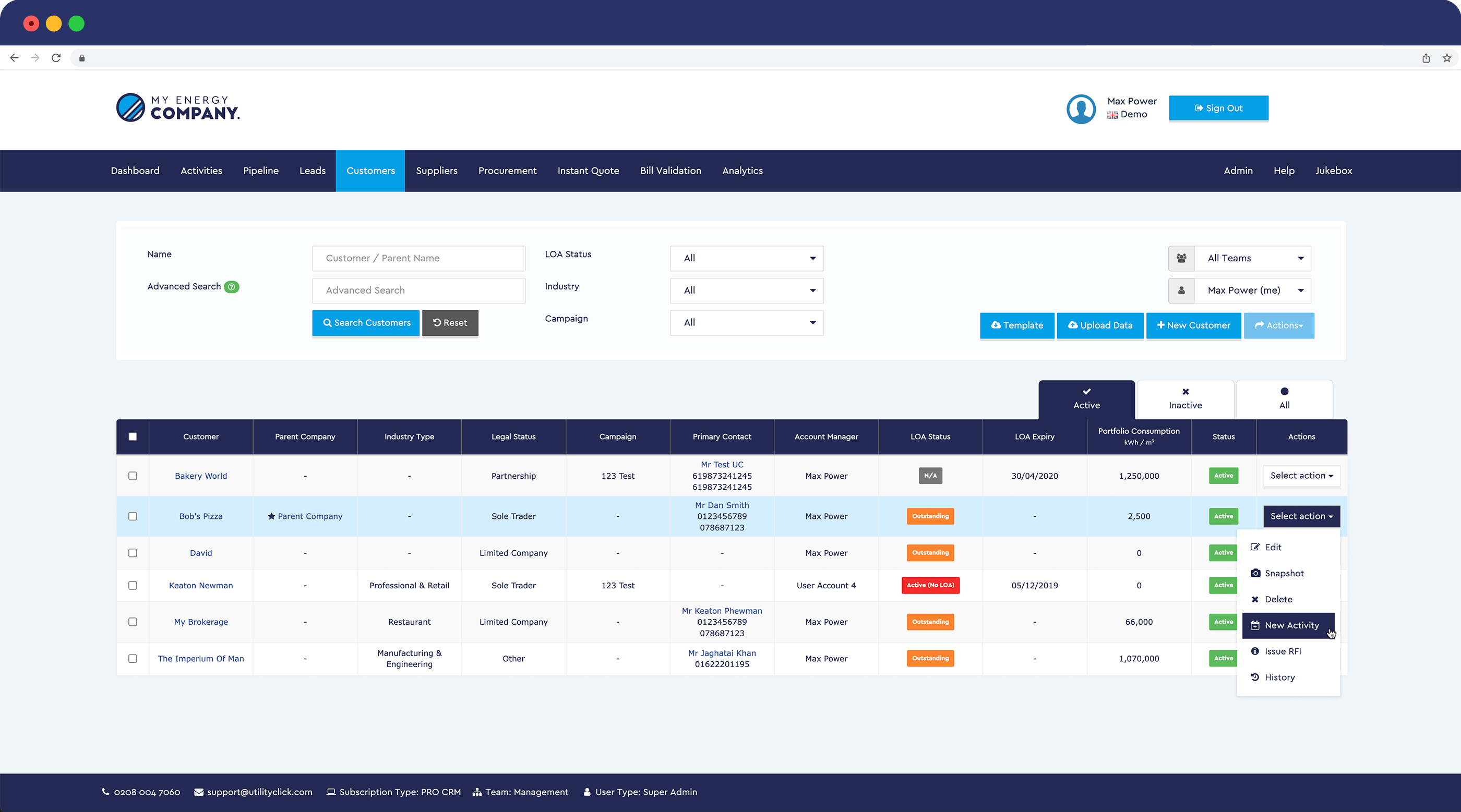Development Update - February 2022
This month:
There's been an undeniable air of excitement in the dev team this month. I can't recall a time when we've had so much R&D work in progress with so much potential to make a huge impact.
One project in particular will give you the option to 'boost' your dashboards. With it, you'll be able to create your very own graphs, tables and reports. For instance: Need to create a dashboard specific to Dan in Sales so he can see what's important in his pipeline? No problem.
The boost will also provide a new dashboard that monitors matrix pricing trends over a period of time. With it, you'll be able to see which suppliers are pricing competitively on various types of meters and when. We'll be in touch again about Dashboard Boosts but if you'd like to get in front of the queue, please contact us or your account manager to signify your interest.
Read on to hear what else we've been up to in the month of February...
Bill Val Thresholds
When validating bills for customers, it's quite often the case that a few pence difference between the 'expected' and 'actual' isn't of vital importance. We've added the ability to set a tolerance threshold of just how far out you'll allow the difference to be, before receiving an alert.
This tolerance can be set individually over almost any aspect of the bill. What's more, you can alter this tolerance on a per-customer basis, should you have certain customers that require more stringent validation than others.
Built for: BILL VAL
Other bits and bobs...
We've also added the following other bits and bobs...
Improved Customer & Lead Snapshot
You can get a quick overview of all the important bits by visiting the Snapshot section within Leads or Customers. We've now added the company number (EIN for the USA) to the Leads and Customers Snapshot screens.
Built for: PRO CRM
Search and Filter Cloud Documents
Within our PRO CRM you can upload any documents that would be useful to store against a lead or customer. We've now added the ability to search through these documents either through their description or by date.
Built for: PRO CRM
New Lost Contract Reasons
When marking a contract as "Lost" you can select from a handful of useful reasons why that contract was lost. We've added more selectable options here to give you a more detailed analysis when reporting.
Built for: PRO CRM
Speedier Detailed Export
Our PRO CRM allows you to export procurement data in varying degrees of complexity. We've made speed improvements to the most "Detailed Export" so it completes much faster.
Built for: PRO CRM
Bill Val UI
As an addition to the threshold work described above, we've improved the user interface of Bill Val reporting so you can now clearly see the actual vs expected difference as a percentage.
Built for: BILL VAL
Approx Commission with Opportunity Exports
Previously when performing a tender export, an "Approx Commission" value would only appear if one had been set manually by the user. However, when viewing a new tender directly within the system, a user is helpfully shown the "Approx Commission" value, even if one has not been set (by using the partner's default broker fee). The process has now been updated so that exports now marry the information provided when viewing an opportunity within the system.
Built for: PRO CRM
That’s it for this month.
Our software evolves at such an exciting rate so please feel free to get in touch to discuss any of the functionality we’ve added since you last saw it. We’ll be more than happy to arrange a demo to show you around!
Does Good Design Matter?
Precursor: In 2020 we wrote an article titled “Could A CRM Give You Pleasure?” which proved rather popular. We’ve also spent much of last year improving the UX of our software.
But WHY?
Does any of it really matter? Thankfully there have been numerous studies to answer this very question…
For example, in 2005 a group called The Design Council studied portfolios of companies that traded on the FTSE over the past 10 years. What they discovered was that the companies that put an emphasis on design outperformed the FTSE 100 index by 200%*.
More recently, in 2015 the National Endowment for the US Arts released a study that concluded that small businesses saw a 17.5% increase in average sales on improved goods and services when they invested in design**.
https://www.arts.gov/sites/default/files/NEAIndustrialDesignManufacturing-4.28.2017-rev.pdf
As Homer Simpson once said:
"Facts are meaningless. You could use facts to prove anything that's even remotely true!"
So let’s drill down into
Five reasons why design doesn't just matter for the energy sector, it's imperative:
Good design has the power to simplify the complex processes that you find in the energy sector.
If you were to create a piece of software that fulfilled every part of your job – that system would be complex to a point of chaos but good design can simplify it all into manageable chunks. If done right, the design can act as a translator, simplifying the complex language of your processes.
Good design can affect users emotions and can actually make your team happier.
It may seem trivial to focus on emotion when talking about software but companies are realising more and more that it’s possible to evoke a positive response from simple interactions, like a hover effect or a popup animation.
Firms such as Apple have built billion-dollar products around how good it can make a user feel, where everything is carefully crafted to give the user a positive experience.
A CRM is much like your phone. You’ll likely spend more time looking at it than you will your own family, so it’s only right that it should also invoke positivity for the user.
Good design can make your team more efficient
As humans, we have an inbuilt nature to take the perceived quickest route to a solution, especially if we’re unsure of the path ahead. When performing a complicated task, good design can provide useful tools precisely where and when they’re needed along a workflow. For instance, having an important button appear more prominent than other page elements can help guide users eyes on where they should go next.
Good design can help highlight your wins and losses
Presenting your data is all well and good but if its meaning is not clear, then it’s likely to be overlooked. This is even more apparent when reporting within the energy sector. Good design can help declutter and present important, actionable information whilst giving the option to drill down to the data that matters. Users can then focus clearly on the presented facts and adapt swiftly to the cause of their wins.
Good design can provide assurances of a high level of service.
If we hold two products side-by-side, we’ll invariably focus on the better-looking of the two. This is where the good design looks to assure us that “If they’ve spent this much effort perfecting how it looks, then the way it works must also be as equally well thought out”.
Although we know that doesn’t always hold true, it’s inbuilt within us and we still can’t help but use it as a base for commercial decisions. When providing completely re-brandable software like ours, it’s even more imperative that when your customers are using it, the way it looks matches the high level of service that you provide.
Summing It All Up
Investing in good design is superficial by its nature but the results will bleed into numerous positive areas, far and beyond aesthetics. Here at UtilityClick we care enormously about the software experiences our users will have, that’s why we invest so much in a design to convey that. We don’t believe any equivalent system can attest to that.
If you’d like to see how we’ve taken these 5 points above (and a few more) to transform our software, get in touch for a demo:


An interactive side-by-side of old Vs. new for our PRO CRM product.

